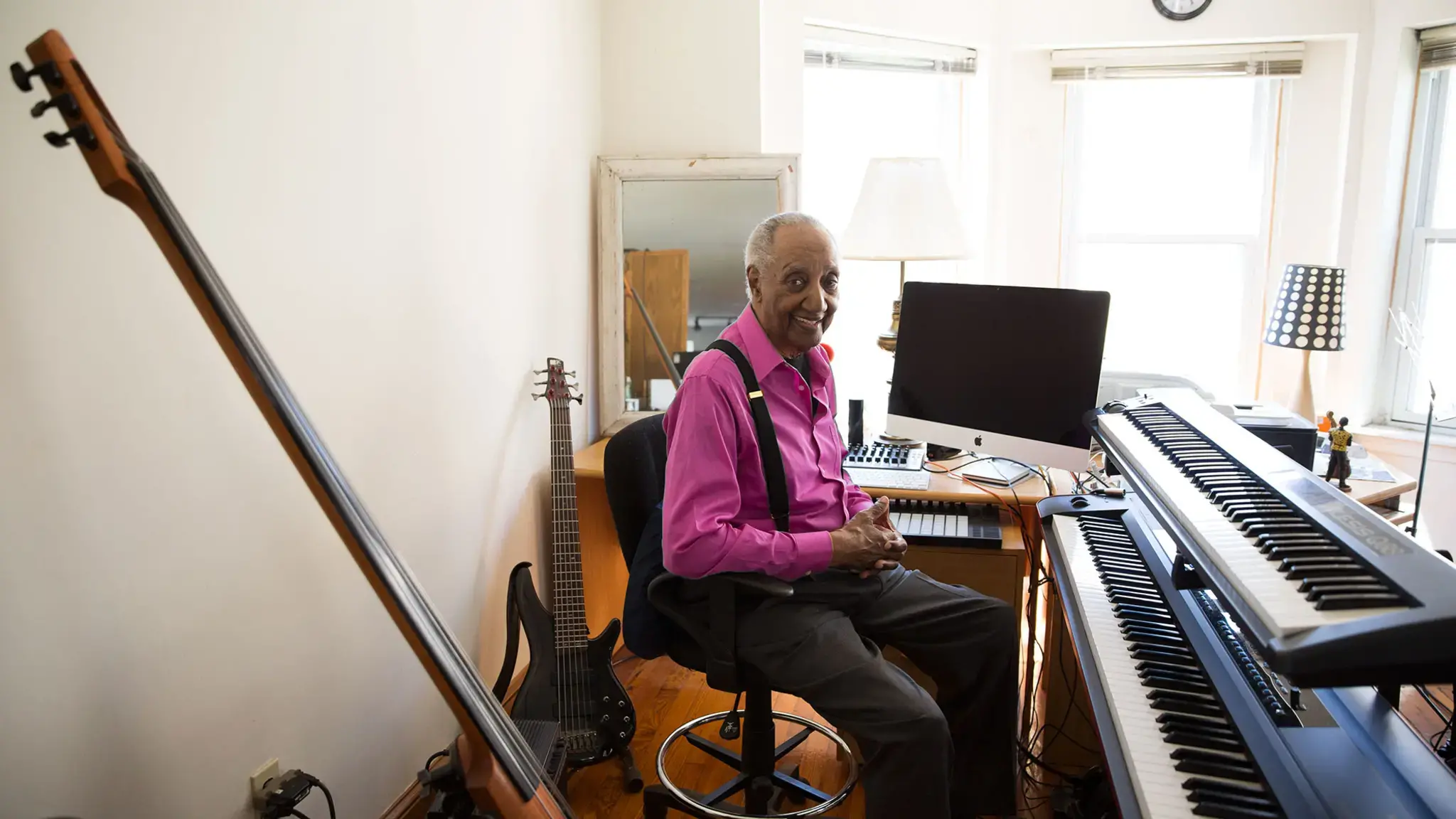This week, we speak to Jymie Merritt (2016) a pioneering bassist and composer who, over the last 60 years, has played with some of the most acclaimed American jazz and blues artists in history, including Art Blakey and The Jazz Messengers, B. B. King, Dizzy Gillespie, Max Roach, and Chet Baker. An early adopter of the electric bass, Merritt established the ensemble The Forerunners in the 1960s, and began developing work that brings forth collective improvisation within a complex rhythmic and harmonic language. Over the past decade, Merritt has been investigating the possibilities of digital composition tools. The recipient of a Philadelphia Jazz Heritage Award, he has been honored with a Living Legend Award from the Philadelphia Clef Club of Jazz and the Performing Arts and the Philadelphia City Council.
How did you become an artist? Is there a particular experience that drove you to this choice?
Art is not an occupation, so I can’t say that I made a choice about it. I never became an artist in the sense of going from one kind of state to another.
What was the first work of art that really mattered to you? Did it influence your approach to your work?
Particular works mattered to me for different reasons. Duke Ellington’s “Black and Tan Fantasy” affected me emotionally when I was five years old. Later, his “Morning Glory” did the same. In Ellington’s “Black Beauty” I heard black life manifested in its life and vitality in modern times. When a friend played Ellington’s “Jack the Bear” with Jimmy Blanton as bassist, my response was to want to become a composer, not a bassist. It only dawned on me later that I had identified strongly with the bass on hearing that piece.
You were an early adopter of the electric bass, and today digital composition tools are an influence on how you work. What do you think will be the biggest influence on the future of your art form?
Electronic music technology will have the biggest influence. We’re coming out of a comfortable period in which the relation between the composer and the performer was more or less spelled out or taken for granted. This relationship won’t be the same—it will become a relationship between the composer and herself. Each composer will have her own digital audio workstation (DAWS) in which to compose and perform every aspect of the work with the desired instrumentation, before and after releasing it for others’ interpretation.
What is your most treasured possession?
My computer workstation is my most treasured possession, as well as, at times, my greatest frustration. Also treasured is a sound library in which I can listen to all the great music of the world. I haven’t taken as much advantage of the latter as I would like to, but I am always hopeful of getting there.
What music are you listening to and/or which books are on your bedside table?
I’m most engaged on a daily basis by broadcast music of all forms and in all settings, whether radio, movies, or television. These are the contemporary sounds that audiences are exposed to and influenced by every day and often all day long—not the music in special settings, such as concert halls. My listening choices are fairly random—whatever comes my way at the moment. Most recently, I’ve been listening to some Cecil Taylor. Also Stanley Cowell. Regarding books, on my nightstand, along with Colson Whitehead’s The Underground Railroad, is the Constitution of the United States, in a handy edition given to me by my lawyer. This document has more to do with form and content than you might imagine. Musically, I’m reading, off and on, Dennis DeSantis’ Making Music; the Apple manuals Logic Pro 10, Garage Band, and Mainstage; and Jon Margulies’ Ableton Live 9 Power!, among other texts.
Tell us about your creative process.
I map out a portion of my musical universe that I haven’t explored yet—the chromatic scale and surrounds; things that are measurable and things that are not. Then I discern patterns (like looking at constellations)—things that are discernible or that I recognize. After I get a sufficient number of elements together that might represent a composition, I examine them independently to see where they might lead—rhythms, harmonic progressions, melodic phrases—and bring them all together into the same context. Although they might not seem cut of the same cloth, I have to find out what they have in common. Next, in the plotting stage, I examine the elements to see how much shape is taking place. As these shapes emerge, I begin to ponder relationships—the fact that they exist there in the same place. I’m more or less stuck with what I find out—with the experience of discerning or discovering. The perfection is already there. I begin to fashion a form and to envision what instruments are involved, and in what way regarding the shapes. I might have a number of plots, and out of these, I will see some relevance regarding topical structures and other aspects that might be going the same way (words, thoughts, etc.) as they relate to musical movements. Right now, I’m working with 36 plots. I’m hoping in the next three years to find a method in which they might all co-exist.
What is perfection to you, in the context of your work?
My striving is for accuracy, not perfection.









